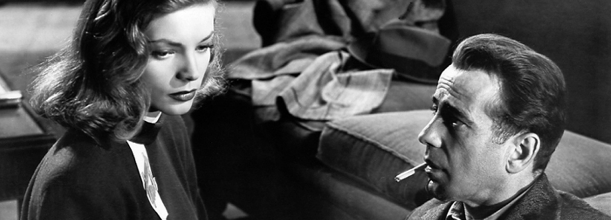Opening Up A Lead And Coming Home Free: The Big Sleep at 65

Perhaps The Big Sleep’s status as one of the best film noirs ever made comes from the way it follows almost none of the usual noir filming rules. Filmed conventionally in bright sunlight rather than darkest night and incorporating no voiceover or flashbacks, the film nevertheless depicts a world where the good and bad of society frequently overlap in a way many noirs could only dream of.
Adapted from legendary hard-boiled fiction writer Raymond Chandler’s novel of the same name, the film introduces Marlowe (Humphrey Bogart) as he visits General Sternwood, an man incapable of controlling his two wild daughters, Vivian (Lauren Bacall) and Carmen. He wants Marlowe to take care of Carmen’s gambling debts. Typically for film noirs, things are not as simple as they seem, and it’s not long before Marlowe is plunged into a world of blackmail, pornography and murder (those things always seem to go hand-in-hand, don’t they?).
The passage of time has not diluted the film’s notoriously convoluted plot, with two separate yet interlocking murders, a multitude of femme fatales, lowlifes and policeman and a host of surprises and double-crosses packed into its 115 minutes. Even the writers were confused – director Howard Hawks sent Chandler a telegram asking if Owen Taylor, the Sternwoods’ chauffeur, had been murdered or if he had committed suicide. Chandler later recalled “Dammit, I didn’t know either!” By the film’s end, though, we couldn’t care less how we got there, as long as all the villains have met bloody or handcuffed ends – what is more interesting to us is the relationship between Marlowe and Vivian.
Bogart, never bettered as the coolest of actors, is at his best here, while his scenes with his real-life wife Bacall sizzle. He was used to leading his female co-stars through films, and evident throughout is his pleasure that twenty-year-old Bacall matches him in every scene they share. Their scenes enable The Big Sleep to be funny and warm, contrasting the bleak and pessimistic mood of the standard noir. In addition to a mass of one-liners (General Sternwood: “How do you like your brandy, sir?” Marlowe: “In a glass.”), there are numerous knowing double-entendres, culminating in the dirtiest conversation anyone has ever had about horses. Ever. Sexy talk has never been done better – who needs Judd Apatow when you’ve got Humph and Loz?
What’s surprising when re-watching the film is how appropriate it feels, especially in the wake of the recent phone-hacking scandal. The society portrayed in The Big Sleep is one preoccupied with façade: showing the right cover story to the public. In the film the media are misled and manipulated, with the DA ripping up some notes which refer to aspects of Marlowe’s tale he wishes to cover up, though today it seems to be the media misinforming the police. Likewise, the legal system is presented as deeply flawed and generally useless, mirroring the less-than-perfect system we have seen struggling to deal with the riots around the country. Though the idea of a corrupt and morally ambiguous society is by no means limited to The Big Sleep, it’s striking how prevalent that culture is within the film.
Like one of Marlowe’s whiskies, The Big Sleep has aged exceedingly well. The script still crackles with wit and the guns still pop like crisp packets. Still relevant 65 years on, don’t worry about following the film – close the Venetian blinds and let Humphrey Bogart guide you into LA’s seedy, sun-drenched underbelly.
By Ben Gallizzi








Recent Comments